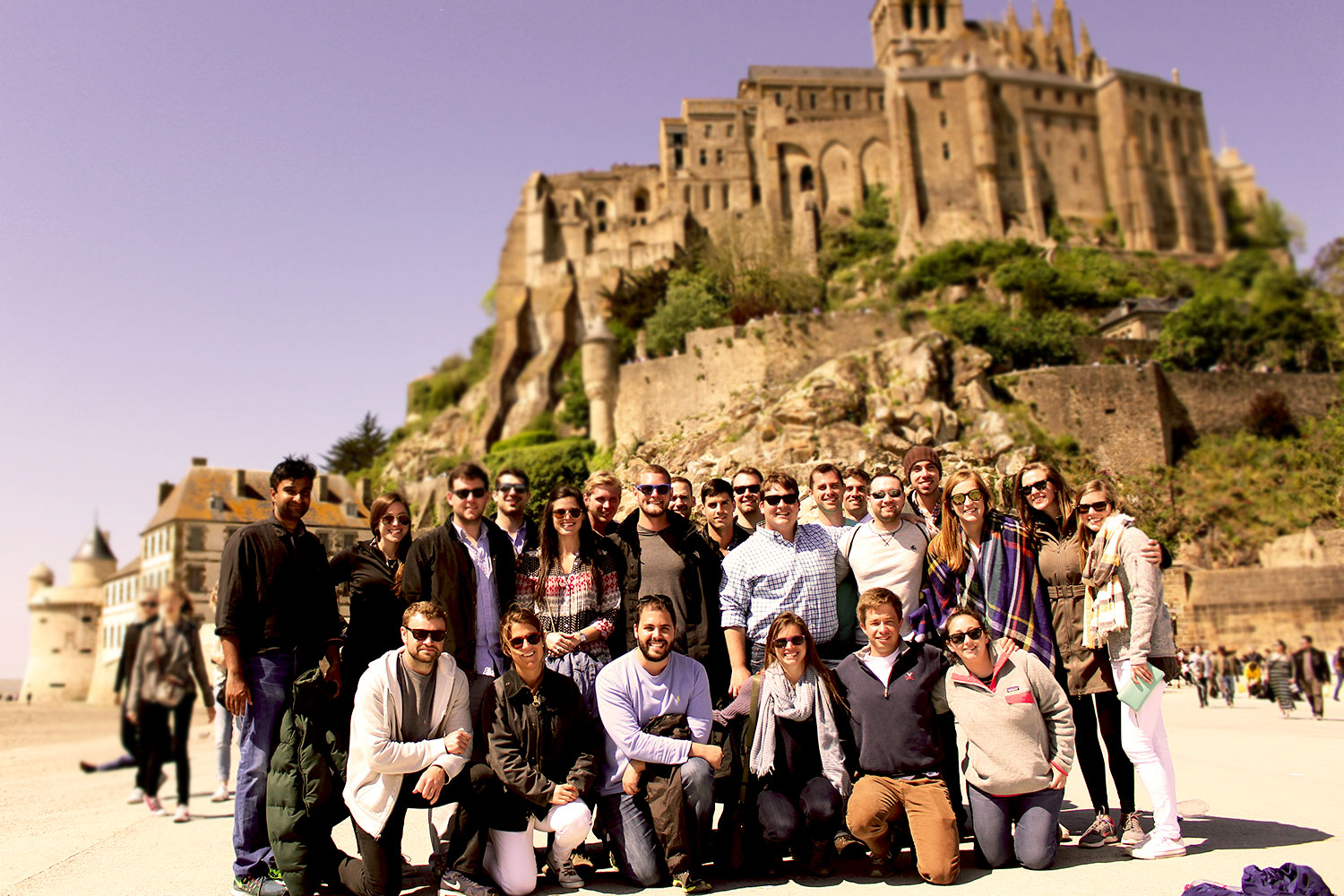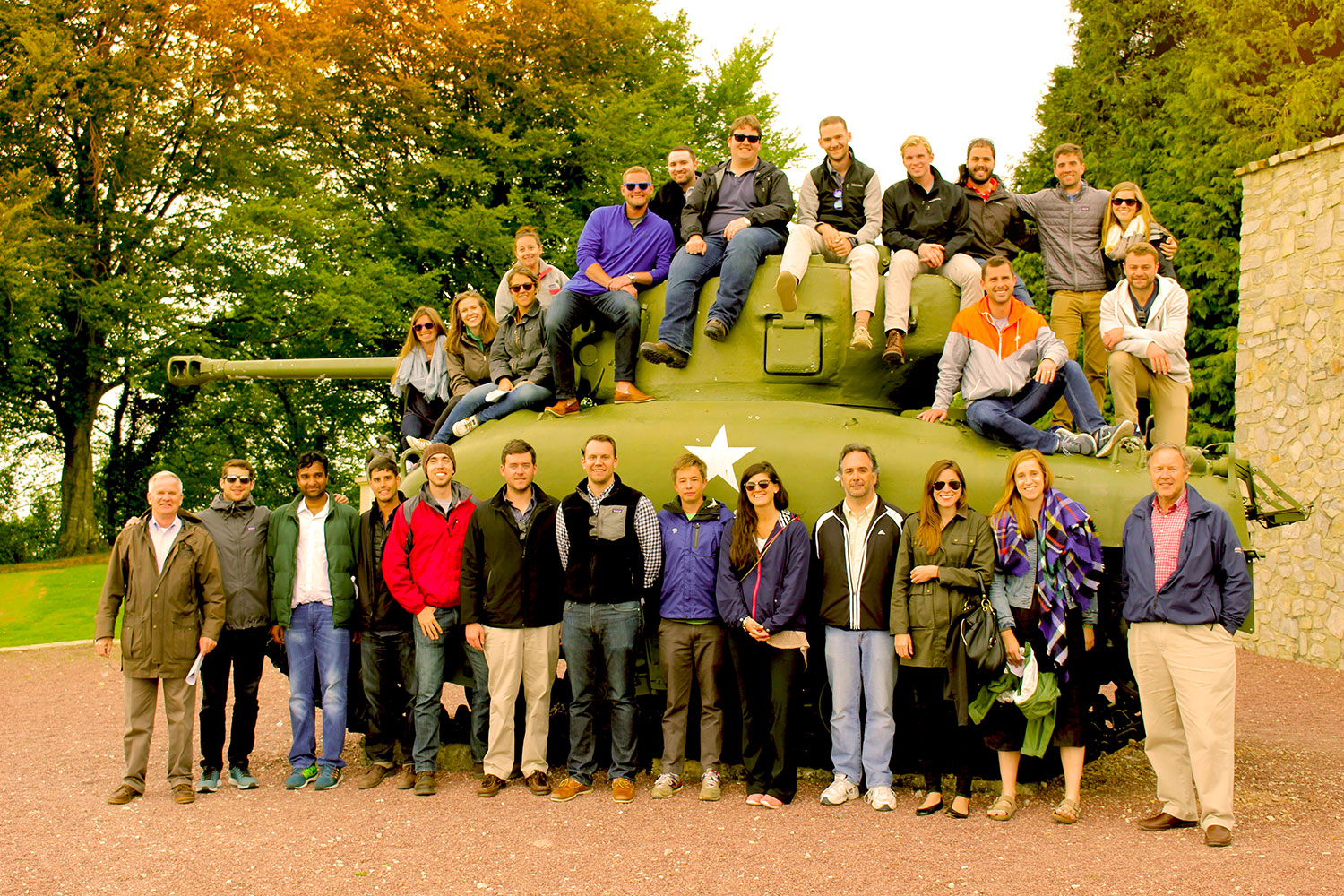Seventy-two years ago, more than 150,000 Allied soldiers amassed to storm occupied France’s heavily fortified Normandy coast in one of the largest amphibious military assaults in history. Today, the impact of the D-Day invasion continues to reverberate, both as a turning point in world history and as a master class for anyone – soldier or civilian – taking on enormously complex tasks.
In May, the invasion site served as a classroom for 24 students in the University of Virginia’s Darden School of Business, who traveled to Normandy to learn more about the leadership and decision-making that fueled the battle’s hard-won success.
“Seeing the actual site and what those soldiers faced as they came up from the water onto Omaha Beach, where some of the machine gun nests are still in place today, it really gives you a humbled sense of the courage, bravery and fortitude of those soldiers,” said Bill Utt, a Darden alumnus and adjunct lecturer. “It is so important for our students to understand what our military achieved, and the size and scope of the operation.”
Utt, who led a Fortune 500 engineering and construction company until his retirement in 2004, co-led the Normandy trip with UVA professor Edward Lengel, who directs the Papers of George Washington collection at UVA, and Gordon Rudd, a professor of strategic studies at the U.S. Marine Corps School of Advanced Warfighting and an adjunct lecturer at Darden. Rudd held four seminars discussing the battle and asked students to read three books prior to the trip: Antony Beevor’s “D-Day: The Battle for Normandy,” Stephen Ambrose’s “D-Day, June 6, 1944” and Samuel Morison’s “The Invasion of France and Germany.”
Rudd also led students on a tour of each of the five beaches where soldiers came ashore, explaining the intricacies of the military operation, while Lengel shared further historical context and comparisons to World War I and Utt offered business corollaries. Student groups also presented papers they had prepared on specific locations.

The group toured the Normandy beaches and Mont Saint-Michel, pictured here.
“To see both the individual perspective and the campaign perspective was hugely valuable,” second-year student Jay Kraska said. Kraska wrote his paper on Utah Beach, where leaders had to abandon their original target and land about 2,000 yards away to avoid strong currents that were sinking other tanks around nearby beaches.
“They made a decision and avoided sinking because a few key leaders decided to bring them in closer to shore,” Kraska said. “They were able to realize they were off-target, think broadly and adapt.”
Some of the students were veterans of operations in Iraq or Afghanistan and could draw parallels with their own military experience.
“Hearing from my classmates who had served was so valuable. Their perspective was not something that I could have recreated on my own,” second-year student Ellen Regan said. “The trip made me never want to go to a historical site without an expert, because having that perspective created a much richer experience.”
Even students with no military experience could make connections between the battlefield and their experiences in business.
“It is tough to make direct comparisons, because the severity of the situation is obviously so different,” Kraska said. “But you can still learn a lot from how the different countries and different branches of the military worked together toward a common goal.”
Students discussed key decisions like how commanders chose to utilize their resources, how a group of paratroopers worked together to achieve their mission even after being dropped off-target, or how German soldiers holding out on a nearby island made the decision to surrender.
In each instance, Utt emphasized business corollaries, including five key themes he outlined for UVA Today.
Contrasting leadership styles: Future U.S. President Dwight D. Eisenhower served as commander of the D-Day operation, called Operation Overlord. Comparing his leadership style with Adolf Hitler’s furnishes lessons for any business student hoping to lead a major organization.
“Hitler did not trust people, did not delegate authority and managed by fear,” Utt said. “Eisenhower delegated when appropriate and was very transparent. Those who needed to know, knew exactly what was going on and why, and as a result he was loved by his military.”
An effective performance management system: Planning for D-Day began a year in advance. Eisenhower and other leaders had to develop the logistics to support their broad mission of retaking France from Germany. That meant creating an effective organizational structure to handle everything from staff support to medical needs or fuel requirements. Anyone who has put on a large event can sympathize with the logistical headaches this must have caused.
“The situation is analogous to a business model where you start with an overall strategy and then have to communicate it to everyone and outline the series of objectives and develop the organization structure necessary to achieve it,” Utt said. “You also have to tie it all together with a rewards system that reinforces the behavior you want everyone to display.”
Strategic capital investment: Before the battle, commanders decided to send an advance group of soldiers to capture Pegasus Bridge, a move that would help stall German reinforcements coming from other parts of France. The decision put those soldiers’ lives at risk, but also proved critical to the battle’s overall success.
“The analogy we made for students was thinking of such decisions as a capital investment,” Utt said. “In the military, you are investing lives to achieve an objective, and you have to know at what point there are too many lives at risk. In business, you are investing money and need to know when to take risks and when to back off.”
Contrasting command models: Students discussed how military hierarchies helped troops succeed, and how different organizational structures might be more or less effective in the business world, where hierarchy does not have to be as strict.
“Businesses have more ambiguity built in, so they can choose between being a bit more democratic or sticking with a clear hierarchy,” Utt said.
Personal career development: At the end of the trip, Utt asked students to think about how D-Day’s lessons could apply to their personal lives and career development, in terms of setting a strategy, developing objectives and deciding how to allocate their money, time and other resources.
“I always recommend that students look at a 30-year career and think of it as 10 three-year business cycles,” he said. “What is your strategy for the next three years? What objectives do you need to achieve? How can you hold yourself accountable?”
Media Contact
Article Information
June 3, 2016
/content/remembering-d-day-leadership-lessons-wwiis-turning-point

